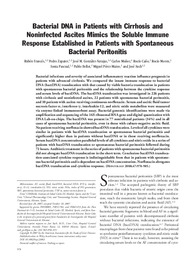Por favor, use este identificador para citar o enlazar este ítem:
https://hdl.handle.net/11000/35362Registro completo de metadatos
| Campo DC | Valor | Lengua/Idioma |
|---|---|---|
| dc.contributor.author | Francés, Rubén | - |
| dc.contributor.author | Zapater, Pedro | - |
| dc.contributor.author | González Navajas, José Manuel | - |
| dc.contributor.author | Muñoz, Carlos | - |
| dc.contributor.author | Caño, Rocío | - |
| dc.contributor.author | Moreu, Rocío | - |
| dc.contributor.author | Pascual, Sonia | - |
| dc.contributor.author | BELLOT, PABLO | - |
| dc.contributor.author | Pérez-Mateo, Miguel | - |
| dc.contributor.author | Such, José | - |
| dc.contributor.other | Departamentos de la UMH::Medicina Clínica | es_ES |
| dc.contributor.other | Departamentos de la UMH::Farmacología, Pediatría y Química Orgánica | es_ES |
| dc.date.accessioned | 2025-01-27T16:05:19Z | - |
| dc.date.available | 2025-01-27T16:05:19Z | - |
| dc.date.created | 2008 | - |
| dc.identifier.citation | Hepatology. 2008 Mar;47(3):978-85 | es_ES |
| dc.identifier.issn | 1527-3350 | - |
| dc.identifier.issn | 0270-9139 | - |
| dc.identifier.uri | https://hdl.handle.net/11000/35362 | - |
| dc.description.abstract | Bacterial infections and severity of associated inflammatory reaction influence prognosis in patients with advanced cirrhosis. We compared the innate immune response to bacterial DNA (bactDNA) translocation with that caused by viable bacteria translocation in patients with spontaneous bacterial peritonitis and the relationship between the cytokine response and serum levels of bactDNA. The bactDNA translocation was investigated in 226 patients with cirrhosis and noninfected ascites, 22 patients with spontaneous bacterial peritonitis, and 10 patients with ascites receiving continuous norfloxacin. Serum and ascitic fluid tumor necrosis factor alpha, interferon-gamma, interleukin-12, and nitric oxide metabolites were measured via enzyme-linked immunosorbent assay. Bacterial genomic identifications were made via amplification and sequencing of the 16S ribosomal RNA gene and digital quantization with DNA Lab-on-chips. The bactDNA was present in 77 noninfected patients (34%) and in all cases of spontaneous bacterial peritonitis, even in those with culture-negative ascitic fluid. No patient receiving norfloxacin showed bactDNA translocation. Levels of all cytokines were similar in patients with bactDNA translocation or spontaneous bacterial peritonitis and significantly higher than in patients without bactDNA or in those receiving norfloxacin. Serum bactDNA concentration paralleled levels of all cytokines and nitric oxide in a series of patients with bactDNA translocation or spontaneous bacterial peritonitis followed during 72 hours. Antibiotic treatment in the series of patients with spontaneous bacterial peritonitis did not abrogate bactDNA translocation in the short term. Conclusion: bactDNA translocation-associated cytokine response is indistinguishable from that in patients with spontaneous bacterial peritonitis and is dependent on bactDNA concentration. Norfloxacin abrogates bactDNA translocation and cytokine response. | es_ES |
| dc.format | application/pdf | es_ES |
| dc.format.extent | 8 | es_ES |
| dc.language.iso | eng | es_ES |
| dc.publisher | Wiley | es_ES |
| dc.rights | info:eu-repo/semantics/openAccess | es_ES |
| dc.rights | Attribution-NonCommercial-NoDerivatives 4.0 Internacional | * |
| dc.rights.uri | http://creativecommons.org/licenses/by-nc-nd/4.0/ | * |
| dc.title | Bacterial DNA in patients with cirrhosis and noninfected ascites mimics the soluble immune response established in patients with spontaneous bacterial peritonitis | es_ES |
| dc.type | info:eu-repo/semantics/article | es_ES |
| dc.relation.publisherversion | 10.1002/hep.22083 | es_ES |

Ver/Abrir:
Bacterial DNA in patients with cirrhosis and noninfected ascites mimics the soluble immune response established in patients with spontaneous bacterial peritonitis.pdf
293,79 kB
Adobe PDF
Compartir:
 La licencia se describe como: Atribución-NonComercial-NoDerivada 4.0 Internacional.
La licencia se describe como: Atribución-NonComercial-NoDerivada 4.0 Internacional.
.png)